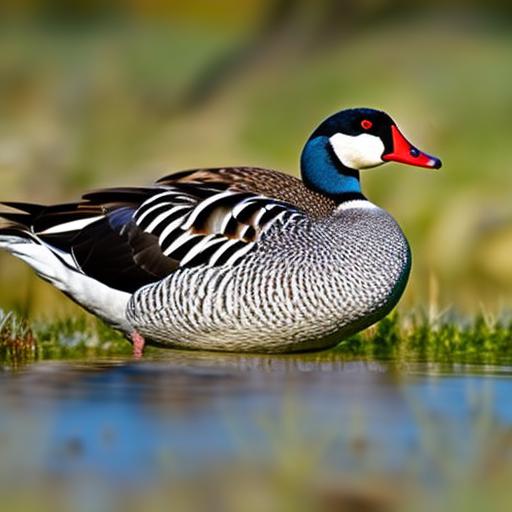Geese have long been an important part of American agriculture and conservation efforts. They are known for their hardiness, adaptability, and usefulness in various aspects of farming. There are several different breeds of geese that are native to North America, each with its own unique characteristics and uses. In this article, we will explore the history and evolution of American geese, their physical characteristics, the differences between domestic and wild geese, the most popular American goose breeds, their role in agriculture and conservation, their behavioral patterns, breeding and rearing practices, health and nutritional requirements, as well as the challenges of raising geese and how to overcome them.
Key Takeaways
- American goose breeds have a rich history and are an important part of agriculture and conservation efforts.
- Physical characteristics of American geese vary between breeds, but all have distinctive features such as a long neck and webbed feet.
- Domestic and wild American geese can be differentiated by their behavior and physical characteristics.
- The most popular American goose breeds include the Toulouse, Embden, and American Buff.
- American geese require proper breeding, rearing, and nutritional care to maintain their health and productivity.
The History and Evolution of American Geese
Geese have a long history in North America, with evidence of their presence dating back thousands of years. They were originally wild birds that migrated across the continent, following the changing seasons and food sources. Over time, some of these wild geese were domesticated in Europe and brought to America by early settlers. These domesticated geese were bred for specific traits such as size, meat production, or egg-laying ability.
The development of American goose breeds began in the 19th century when breeders started selectively breeding geese for specific traits. This led to the creation of distinct breeds such as the Toulouse, Embden, and Pilgrim geese. These breeds were further refined over time to improve their characteristics and meet the needs of farmers.
Physical Characteristics of American Goose Breeds
American goose breeds vary in size, weight, and coloration. The Toulouse goose is one of the largest breeds, weighing up to 30 pounds (13.6 kg) for males and 20 pounds (9 kg) for females. They have a gray plumage with a white underbelly. The Embden goose is also a large breed, with males weighing up to 26 pounds (11.8 kg) and females weighing up to 20 pounds (9 kg). They have a white plumage and a distinctive knob on their forehead.
Other popular American goose breeds include the Pilgrim goose, which is a medium-sized breed with a white plumage and a black knob on its forehead, and the American Buff goose, which is a smaller breed with a buff-colored plumage. Each breed has its own unique physical features that make them easily distinguishable from one another.
Differentiating Between Domestic and Wild American Geese
It is important to understand the differences between domestic and wild geese, as this knowledge can greatly impact conservation efforts. Domestic geese have been selectively bred for specific traits and are typically larger and heavier than their wild counterparts. They also have different colorations, with domestic geese often having white or gray plumage, while wild geese can have a variety of colors.
Behaviorally, domestic geese are more docile and less likely to fly long distances compared to wild geese. Domestic geese are also more likely to rely on humans for food and protection, while wild geese are more self-sufficient and rely on natural food sources.
Understanding these differences is crucial for conservation efforts, as it allows researchers to accurately identify and track wild populations. It also helps in developing strategies to protect and preserve wild goose populations.
The Most Popular American Goose Breeds
There are several popular American goose breeds that are widely recognized for their unique characteristics and uses. The Toulouse goose is one of the most popular breeds due to its large size and excellent meat production. It is known for its tender and flavorful meat, making it a favorite among farmers and consumers alike.
The Embden goose is another popular breed, prized for its large size and white plumage. It is often used for meat production but can also be kept for ornamental purposes due to its striking appearance.
The Pilgrim goose is a smaller breed that is known for its excellent egg-laying ability. It is a popular choice for small-scale farmers and backyard enthusiasts who are interested in raising geese for eggs rather than meat.
The American Buff goose is a smaller breed that is prized for its calm and friendly temperament. It is often kept as a pet or for exhibition purposes, although it can also be raised for meat or eggs.
The Role of American Geese in Agriculture and Conservation

American geese play a vital role in both agriculture and conservation efforts. In agriculture, geese are valued for their meat, eggs, and pest control abilities. Geese are excellent grazers and can help control weeds and pests in fields, reducing the need for chemical pesticides. They also provide a source of income through the sale of meat and eggs.
In terms of conservation, geese play a crucial role in habitat restoration and population management. Geese are often used to restore wetland habitats by grazing on invasive plant species and creating open areas for native plants to thrive. They also help maintain biodiversity by dispersing seeds through their droppings.
Population management is another important aspect of goose conservation. Some goose populations, such as the Canada goose, have become overabundant in certain areas, leading to conflicts with humans and damage to agricultural crops. By implementing population management strategies such as egg addling or controlled hunting, the balance between geese and their environment can be maintained.
The Behavioral Patterns of American Geese
Geese are highly social animals that live in flocks and exhibit complex behaviors. In the wild, geese form strong pair bonds and mate for life. They communicate with each other through a variety of vocalizations, body postures, and displays.
Within a flock, there is a hierarchical structure with dominant individuals asserting their authority over subordinate ones. This hierarchy is often established through aggressive displays and physical interactions.
In domestic settings, geese can also exhibit social behaviors, although their interactions may be influenced by their human caretakers. Domestic geese are known to form strong bonds with their owners and can become quite tame with regular handling and socialization.
Breeding and Rearing American Geese
Breeding and rearing geese can be a rewarding experience, but it requires careful planning and attention to detail. Geese typically reach sexual maturity at around two years of age. During the breeding season, males will engage in courtship displays to attract females. Once a pair has formed, they will build a nest together and the female will lay her eggs.
Geese are excellent parents and will take turns incubating the eggs and caring for the goslings once they hatch. However, it is important to provide a safe and secure environment for the nesting geese to prevent predation or disturbance.
Rearing goslings requires providing them with proper nutrition, shelter, and protection from predators. Goslings should be fed a balanced diet that includes a mix of grains, greens, and protein sources. They should also have access to clean water for drinking and bathing.
Health and Nutritional Requirements of American Geese
Like any livestock animal, geese have specific health and nutritional requirements that must be met to ensure their well-being. Common health issues in geese include respiratory infections, parasites, and foot problems. Regular veterinary care, proper nutrition, and good hygiene practices can help prevent these issues.
Geese require a balanced diet that includes a mix of grains, greens, and protein sources. They should have access to fresh water at all times for drinking and bathing. It is also important to provide them with adequate shelter to protect them from extreme weather conditions.
Challenges of Raising American Geese and How to Overcome Them
Raising geese can come with its own set of challenges, but with proper planning and management, these challenges can be overcome. One common challenge is predator control, as geese are vulnerable to attacks from predators such as foxes, raccoons, and birds of prey. Implementing predator-proof fencing and providing secure housing can help protect geese from predation.
Another challenge is providing adequate housing for geese, especially during extreme weather conditions. Geese require shelter that is well-ventilated, dry, and protected from drafts. Providing bedding material such as straw or wood shavings can help keep geese warm and comfortable.
Overall, raising American geese can be a rewarding endeavor that offers numerous benefits in terms of agriculture and conservation. By understanding the history, characteristics, and needs of American goose breeds, farmers and conservationists can make informed decisions and contribute to the preservation of these remarkable birds.
If you’re interested in learning more about American geese breeds, you might also find this article on poultrywizard.com helpful. It discusses the importance of providing a suitable coop for your chickens, such as the SnapLock Chicken Coop. Having a well-designed coop is crucial for the health and safety of your birds. Check out the article here: https://poultrywizard.com/keeping-chickens/what-kind-of-coop-is-best-for-chickens/.
FAQs
What are American geese breeds?
American geese breeds refer to the different types of geese that are native to North America. These breeds are known for their adaptability to different environments and their ability to thrive in various climates.
What are the most common American geese breeds?
The most common American geese breeds include the Canada goose, the snow goose, the brant goose, the cackling goose, and the Ross’s goose. These breeds are found throughout North America and are known for their distinctive physical characteristics and behaviors.
What is the size of American geese breeds?
American geese breeds vary in size depending on the breed. The Canada goose is the largest of the American geese breeds, with a wingspan of up to six feet and a weight of up to 20 pounds. The Ross’s goose, on the other hand, is the smallest of the American geese breeds, with a wingspan of up to three feet and a weight of up to four pounds.
What is the lifespan of American geese breeds?
The lifespan of American geese breeds varies depending on the breed and the environment in which they live. In general, American geese breeds can live up to 20 years in the wild and up to 30 years in captivity.
What is the diet of American geese breeds?
American geese breeds are herbivores and primarily feed on grasses, grains, and aquatic plants. They also eat insects, snails, and other small animals on occasion.
What is the habitat of American geese breeds?
American geese breeds are found throughout North America and can adapt to a variety of habitats, including wetlands, grasslands, and agricultural areas. They are also commonly found near bodies of water such as lakes, rivers, and ponds.
Meet Walter, the feathered-friend fanatic of Florida! Nestled in the sunshine state, Walter struts through life with his feathered companions, clucking his way to happiness. With a coop that’s fancier than a five-star hotel, he’s the Don Juan of the chicken world. When he’s not teaching his hens to do the cha-cha, you’ll find him in a heated debate with his prized rooster, Sir Clucks-a-Lot. Walter’s poultry passion is no yolk; he’s the sunny-side-up guy you never knew you needed in your flock of friends!







